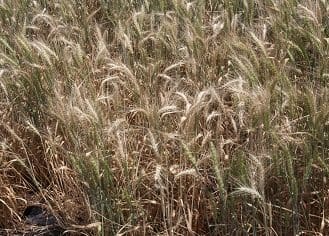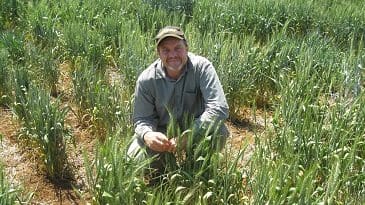FARMERS last year demonstrated they are becoming much more adept at countering the threat of crown rot disease – but it’s no time to rest on their laurels, according to NSW Department of Primary Industries (DPI) senior plant pathologist, Steven Simpfendorfer, Tamworth.
Crown rot remains a threat to winter cereal production throughout the farming belt, despite better management programs, resistant varieties and a surge in chickpea plantings in recent years that have helped break the disease cycle.
“With chickpeas becoming a bigger part of the rotation in the last couple of years, that has given a better break for crown rot,” Dr Simpfendorfer said.
“The increased adoption of wheat varieties such as Suntop, Mustang, Spitfire and Lancer has also helped. The varieties that are coming through have better tolerance, Suntop in particular. Farmers have got away from Gregory which was more susceptible. We are still seeing losses, but not at the same levels.
“The thing in the north is a variety should have good tolerance to both crown rot and Pratylenchus thorneii (root lesion nematodes) which Suntop has. If a variety hasn’t got both it is in a world of pain.”
Continue sound strategies
Dr Simpfendorfer said farmers should take heart from the success they had had managing the disease in recent years and continue to apply the strategies that were proving effective.

Crown rot infection is characterised by a light honey-brown to dark brown discolouration of the base of infected tillers, while major yield loss from the production of whiteheads is related to moisture stress post-flowering.
He said last year had been a high-risk year for the expression of crown rot as whiteheads in cereal crops thanks to a warmer winter and a dry spring, but the disease was generally well managed in the majority of paddocks by NSW and Queensland growers.
“To see the number of paddocks that didn’t have whiteheads in them showed growers had actually got somewhere with their management. There were still some paddocks affected, but as a general rule, growers are making progress,” he said.
“So, don’t be disheartened or forget the principles just because you have the odd paddock affected.”
Dr Simpfendorfer said trials comparing crops inoculated with crown rot to those not inoculated graphically showed those growers who thought they weren’t making progress just what could happen if crown rot wasn’t managed effectively.
“For growers with some paddocks that had only five to 10 per cent affected, if they weren’t managing crown rot inoculum through rotation and other means their paddocks would be looking like the inoculated sites in the trials. Their crops could have been sitting at 50 per cent loss. It would have been a big year for losses,” he said.
Inoculum widespread
Further south, NSW DPI cereal pathology technical officer, Brad Baxter, Wagga Wagga, said a survey from 2014 of 93 paddocks in southern NSW in a cereal phase pre-sowing and post-harvest showed crown rot inoculum was widespread.
“We are also finding from the survey that there are commonly one or more stubble-borne diseases in consultation with crown rot. Seasonal selection will see the expression of one or other of the diseases,” he said.
Mr Baxter said there were high inoculum loads throughout southern areas coming into the winter cropping season.
“If you observed symptoms in a paddock last year, go to a break crop. If you can’t go to a break crop, consider sowing barley over wheat. Because of its phenology it will fill grain quicker, potentially avoiding moisture and heat stress which exacerbate losses from crown rot,” he said.
“Other things you can do are sow early in the window to try to minimise moisture and heat stresses during grain fill.”
Mr Baxter said the key points to remember with crown rot were:
- The longer you grow a cereal in succession, it will increase pre-sowing crown rot levels from low to high.
- Know your risk factors and monitor inoculum levels by using Predicta B stem browning assessments.
- Know how many cereals were grown in a row. When was your last break crop?
- Crown rot will cause yield penalties and downgrade grain quality without the obvious expression of symptoms.
- Growing two consecutive, non-host, non-cereal crops in a row will drive down inoculum levels.
Heavy losses in cereals
In Western Australia, Department of Primary Industries and Regional Development (DPIRD) researchers have found that growers can lose up to 18-19 per cent of potential barley and wheat yields due to crown rot.
The prevalence is particularly high in the state’s ‘hot spot’, the low rainfall eastern grainbelt, mainly due to the common use of cereal-cereal rotations in that region.
Wheat and barley trials carried out by DPIRD at Merredin and Wongan Hills from 2014 to 2016 found:
- Barley average yield losses from crown rot infection ranged from 0.19 to 0.53 tonnes per hectare (8-28 per cent) across 15 varieties
- Wheat average losses ranged from 0.24 to 0.65 tonnes per hectare (10-31 per cent) for 13 varieties.
DPIRD research officer Dr Daniel Hüberli said for wheat, the best performing variety under high crown rot inoculum was Emu Rock. For barley, it was Litmus and La Trobe.
…………………..
*PreDicta B is a DNA-based test for stubble, plant residue and soil which detects levels of a range of cereal pathogens. It is commercially available to growers through the South Australian Research and Development Institute (SARDI).
For more information on crown rot management go to https://grdc.com.au/resources-and-publications/all-publications/bookshop/2011/01/crown-rot-in-cereals-fact-sheet-northern-region
Grain Central: Get our free daily cropping news straight to your inbox – Click here



HAVE YOUR SAY